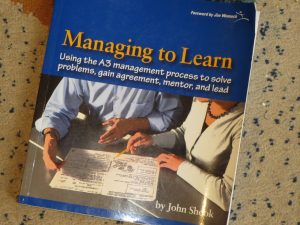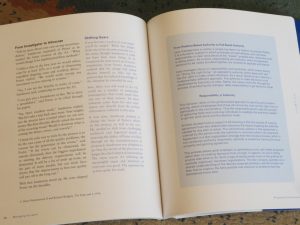At the recent Australasia Lean Summit, there was one book that kept coming up in conversation, both by the presenters and the general attendees – Managing to Learn by John Shook. It was referred to as the way to approach developing people into problem solvers and mentoring them into avoiding the “jumping to a solution” method.
Managing to Learn brings to life the woes of Acme Manufacturing and introduces us to Ken Sanderson, site manager and his middle manager Desi Porter. The book offers us information in three different modes.
Mode One – Assigned to Solve the Problems
The first tells us the story of how Porter is assigned to solve the problems with the document translation process, and the steps he takes to fix the problems that have led to late plant start-up previously. It is a process that is largely information- and skill-based, rather than your typical automotive manufacturing case study.
Mode Two – Coaching Through the Problem Solving Pprocess
The second mode, which runs parallel to the story, is the thinking of Sanderson as he coaches and mentors Porter through the problem solving process. It offers comfort through the expression of Sanderson’s frustration in not simply telling Porter what he should do, but ask questions and guides him to discovering his own path; I could certainly identify Sanderson’s sentiments of wanting to just get on with telling Porter what to do, rather than helping develop his own skills.
Mode Three – Information Blocks
The third mode of information throughout the book are the information blocks. These summarise the key points needed to understand the principles behind the theory that Sanderson and Porter are working through. The progressive A3 plans are also included, allowing us to see how they are developed and clarified as the story unfolds.
No One Right Solution
The usual lean text book themes of “going to the gemba” and “Asking why” are reinforced throughout that book. The concept of knowingly having several countermeasures, to be trialled and refined, was an light-bulb moment for me. How often do we realise that there is simply not one cause, and therefore not just one “right” solution to any process we are trying to improve? The text allows that there are many contributing factors, even when the “root cause” has been thoroughly investigated. So it’s reasonable to need more than one countermeasure to improve these varying contributing factors.
The multiple-countermeasure concept also reinforces the mindset of approaching these solutions to the countermeasures as trials or experiments.
I see this as hugely beneficial for both technical staff and management who are often desperate to prove “their solution” is the correct one, when it is only part of the overall picture. By approaching each part of the solution puzzle as a trial, we can allow ourselves to objectively determine how well that countermeasure resolved the suspected root cause and LEARN from taking these steps. They allow us to see the shades of gray and not run hot or cold – no problem, even in manufacturing, is ever “black or white”.
Managing to Learn summarises these thoughts nicely.
Managing To Learn is A Great Book for A3 and Problem Solving
I would recommend this book as the handbook for using A3s and problem solving thinking as a way of developing your people across all levels of your organisation.
Each level of management can mentor the level below and each level can solve problems at their level. Just imagine what your business would look like after 12 months of problem solving by an army of problem-solving thinkers.







